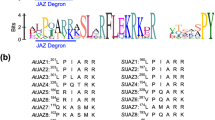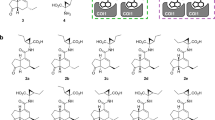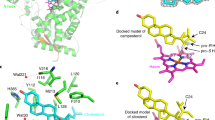Abstract
Jasmonates are lipid-derived plant hormones that regulate plant defenses and numerous developmental processes. Although the biosynthesis and molecular function of the most active form of the hormone, (+)-7-iso-jasmonoyl-L-isoleucine (JA-Ile), have been unraveled, it remains poorly understood how the diversity of bioactive jasmonates regulates such a multitude of plant responses. Bioactive analogs have been used as chemical tools to interrogate the diverse and dynamic processes of jasmonate action. By contrast, small molecules impairing jasmonate functions are currently unknown. Here, we report on jarin-1 as what is to our knowledge the first small-molecule inhibitor of jasmonate responses that was identified in a chemical screen using Arabidopsis thaliana. Jarin-1 impairs the activity of JA-Ile synthetase, thereby preventing the synthesis of the active hormone, JA-Ile, whereas closely related enzymes are not affected. Thus, jarin-1 may serve as a useful chemical tool in search for missing regulatory components and further dissection of the complex jasmonate signaling networks.
This is a preview of subscription content, access via your institution
Access options
Subscribe to this journal
Receive 12 print issues and online access
$259.00 per year
only $21.58 per issue
Buy this article
- Purchase on Springer Link
- Instant access to full article PDF
Prices may be subject to local taxes which are calculated during checkout




Similar content being viewed by others
Accession codes
References
Kazan, K. & Manners, J.M. Jasmonate signaling: toward an integrated view. Plant Physiol. 146, 1459–1468 (2008).
Wasternack, C. & Hause, B. Jasmonates: biosynthesis, perception, signal transduction and action in plant stress response, growth and development. An update to the 2007 review in Annals of Botany. Ann. Bot. 111, 1021–1058 (2013).
Staswick, P.E. & Tiryaki, I. The oxylipin signal jasmonic acid is activated by an enzyme that conjugates it to isoleucine in Arabidopsis. Plant Cell 16, 2117–2127 (2004).
Miersch, O., Neumerkel, J., Dippe, M., Stenzel, I. & Wasternack, C. Hydroxylated jasmonates are commonly occuring metabolites of jasmonic acid and contribute to a partial switch-off in jasmonate signaling. New Phytol. 117, 114–127 (2008).
Koo, A.J. & Howe, G.A. Catabolism and deactivation of the lipid-derived hormone jasmonoyl-isoleucine. Front. Plant Sci. 3, 19 (2012).
Kombrink, E. Chemical and genetic exploration of jasmonate biosynthesis and signaling paths. Planta 236, 1351–1366 (2012).
Lorenzo, O., Chico, J.M., Sánchez-Serrano, J.J. & Solano, R. JASMONATE-INSENSITIVE1 encodes a MYC transcription factor essential to discriminate between different jasmonate-regulated defense responses in Arabidopsis. Plant Cell 16, 1938–1950 (2004).
Dombrecht, B. et al. MYC2 differentially modulates diverse jasmonate-dependent functions in Arabidopsis. Plant Cell 19, 2225–2245 (2007).
Fonseca, S. et al. (+)-7-iso-Jasmonoyl-l-isoleucine is the endogenous bioactive jasmonate. Nat. Chem. Biol. 5, 344–350 (2009).
Thines, B. et al. JAZ repressor proteins are targets of the SCFCOI1 complex during jasmonate signalling. Nature 448, 661–665 (2007).
Chini, A. et al. The JAZ family of repressors is the missing link in jasmonate signalling. Nature 448, 666–671 (2007).
Yan, Y. et al. A downstream mediator in the growth repression limb of the jasmonate pathway. Plant Cell 19, 2470–2483 (2007).
Glauser, G. et al. Spatial and temporal dynamics of jasmonate synthesis and accumulation in Arabidopsis in response to wounding. J. Biol. Chem. 283, 16400–16407 (2008).
Chung, H.S. et al. Regulation and function of Arabidopsis JASMONATE ZIM-domain genes in response to wounding and herbivory. Plant Physiol. 146, 952–964 (2008).
Sheard, L.B. et al. Jasmonate perception by inositol-phosphate-potentiated COI1-JAZ co-receptor. Nature 468, 400–405 (2010).
Katsir, L., Schilmiller, A.L., Staswick, P.E., He, S.Y. & Howe, G.A. COI1 is a critical component of a receptor for jasmonate and the bacterial virulence factor coronatine. Proc. Natl. Acad. Sci. USA 105, 7100–7105 (2008).
Santner, A. & Estelle, M. Recent advances and emerging trends in plant hormone signalling. Nature 459, 1071–1078 (2009).
Heitz, T. et al. Cytochromes P450 CYP94C1 and CYP94B3 catalyze two successive oxidation steps of plant hormone jasmonoyl-isoleucine for catabolic turnover. J. Biol. Chem. 287, 6296–6306 (2012).
Widemann, E. et al. The amidohydrolases IAR3 and ILL6 contribute to jasmonoyl-isoleucine hormone turnover and generate 12-hydroxy-jasmonic acid upon wounding in Arabidopsis leaves. J. Biol. Chem. 288, 31701–31714 (2013).
Glauser, G. et al. Velocity estimates for signal propagation leading to systemic jasmonic acid accumulation in wounded Arabidopsis. J. Biol. Chem. 284, 34506–34513 (2009).
Browse, J. The power of mutants for investigating jasmonate biosynthesis and signaling. Phytochemistry 70, 1539–1546 (2009).
McCourt, P. & Desveaux, D. Plant chemical genetics. New Phytol. 185, 15–26 (2010).
Hicks, G.R. & Raikhel, N.V. Small molecules present large opportunities in plant biology. Annu. Rev. Plant Biol. 63, 261–282 (2012).
Armstrong, J.I., Yuan, S., Dale, J.M., Tanner, V.N. & Theologis, A. Identification of inhibitors of auxin transcriptional activation by means of chemical genetics in Arabidopsis. Proc. Natl. Acad. Sci. USA 101, 14978–14983 (2004).
Park, S.-Y. et al. Abscisic acid inhibits type 2C protein phosphatases via the PYR/PYL family of START proteins. Science 324, 1068–1071 (2009).
Lin, L.-C., Hsu, J.-H. & Wang, L.-C. Identification of novel inhibitors of 1-aminocyclopropane-1-carboxylic acid synthase by chemical screening in Arabidopsis thaliana. J. Biol. Chem. 285, 33445–33456 (2010).
De Rybel, B. et al. Chemical inhibition of a subset of Arabidopsis thaliana GSK3-like kinases activates brassinosteroid signaling. Chem. Biol. 16, 594–604 (2009).
De Rybel, B. et al. A role for the root cap in root branching revealed by the non-auxin probe naxillin. Nat. Chem. Biol. 8, 798–805 (2012).
Meesters, C. & Kombrink, E. in Plant Chemical Genomics: Methods and Protocols, Methods in Molecular Biology Vol. 1056 (eds. Glenn R. Hicks & Stéphanie Robert) 19–31 (Humana Press, 2014).
Jensen, A.B., Raventos, D. & Mundy, J. Fusion genetic analysis of jasmonate-signalling mutants in Arabidopsis. Plant J. 29, 595–606 (2002).
Serrano, M., Hubert, D.A., Dangl, J.L., Schulze-Lefert, P. & Kombrink, E. A chemical screen for suppressors of the avrRpm1–RPM1-dependent hypersensitive cell death response in Arabidopsis thaliana. Planta 231, 1013–1023 (2010).
Darrouzet, E., Issartel, J.-P., Lunardi, J. & Dupuis, A. The 49-kDa subunit of NADH-ubiquinone oxidoreductase (Complex I) is involved in the binding of piericidin and rotenone, two quinone-related inhibitors. FEBS Lett. 431, 34–38 (1998).
Ellis, C. & Turner, J.G. The Arabidopsis mutant cev1 has constitutively active jasmonate and ethylene signal pathways and enhanced resistance to pathogens. Plant Cell 13, 1025–1033 (2001).
Serrano, M. et al. Chemical interference of pathogen-associated molecular pattern-triggered immune responses in Arabidopsis reveals a potential role for fatty-acid synthase type II complex-derived lipid signals. J. Biol. Chem. 282, 6803–6811 (2007).
Bartsch, M. et al. Accumulation of isochorismate-derived 2,3-dihydroxybenzoic 3-O-β-d-xyloside in Arabidopsis resistance to pathogens and ageing of leaves. J. Biol. Chem. 285, 25654–25665 (2010).
Shan, X., Zhang, Y., Peng, W., Wang, Z. & Xie, D. Molecular mechanism for jasmonate-induction of anthocyanin accumulation in Arabidopsis. J. Exp. Bot. 60, 3849–3860 (2009).
Groll, M. et al. A plant pathogen virulence factor inhibits the eukaryotic proteasome by a novel mechanism. Nature 452, 755–758 (2008).
Yan, J. et al. The Arabidopsis CORONATINE INSENSITIVE1 protein is a jasmonate receptor. Plant Cell 21, 2220–2236 (2009).
Chen, Q., Westfall, C.S., Hicks, L.M., Wang, S. & Jez, J.M. Kinetic basis for the conjugation of auxin by a GH3 family indole–acetic acid–amido synthetase. J. Biol. Chem. 285, 29780–29786 (2010).
Westfall, C.S. et al. Structural basis for prereceptor modulation of plant hormones by GH3 proteins. Science 336, 1708–1711 (2012).
Vergnolle, O., Xu, H. & Blanchard, J.S. Mechanism and regulation of mycobactin fatty acyl-AMP ligase FadD33. J. Biol. Chem. 288, 28116–28125 (2013).
Staswick, P.E., Tiryaki, I. & Rowe, M.L. Jasmonate response locus JAR1 and several related Arabidopsis genes encode enzymes of the firefly luciferase superfamily that show activity on jasmonic, salicylic, and indole-3-acetic acids in an assay for adenylation. Plant Cell 14, 1405–1415 (2002).
Shockey, J.M., Fulda, M.S. & Browse, J. Arabidopsis contains a large superfamily of acyl-activating enzymes. Phylogenetic and biochemical analysis reveals a new class of acyl-coenzyme A synthetases. Plant Physiol. 132, 1065–1076 (2003).
Staswick, P.E. et al. Characterization of an Arabidopsis enzyme family that conjugates amino acids to indole-3-acetic acid. Plant Cell 17, 616–627 (2005).
Suza, W.P. & Staswick, P. The role of JAR1 in jasmonoyl-l-isoleucine production during Arabidopsis wound response. Planta 227, 1221–1232 (2008).
Westfall, C.S., Muehler, A.M. & Jez, J.M. Enzyme action in the regulation of plant hormone responses. J. Biol. Chem. 288, 19304–19311 (2013).
Noutoshi, Y. et al. Novel plant immune-priming compounds identified via high-throughput chemical screening target salicylic acid glucosyltransferases in Arabidopsis. Plant Cell 24, 3795–3804 (2012).
He, W. et al. A small-molecule screen identifies l-kynurenine as a competitive inhibitor of TAA1/TAR activity in ethylene-directed auxin biosynthesis and root growth in Arabidopsis. Plant Cell 23, 3944–3960 (2011).
Okrent, R.A. & Wildermuth, M.C. Evolutionary history of the GH3 family of acyl adenylases in rosids. Plant Mol. Biol. 76, 489–505 (2011).
Walsh, T.A. et al. Chemical genetic identification of glutamine phosphoribosylpyrophosphate amidotransferase as the target for a novel bleaching herbicide in Arabidopsis. Plant Physiol. 144, 1292–1304 (2007).
Zheng, W. et al. Bestatin, an inhibitor of aminopeptidases, provides a chemical genetics approach to dissect jasmonate signaling in Arabidopsis. Plant Physiol. 141, 1400–1413 (2006).
Ulmasov, T., Murfett, J., Hagen, G. & Guilfoyle, T.J. Aux/IAA proteins repress expression of reporter genes containing natural and highly active synthetic auxin response elements. Plant Cell 9, 1963–1971 (1997).
Gray, W.M., Kepinski, S., Rouse, D., Leyser, O. & Estelle, M. Auxin regulates SCFTIR1-dependent degradation of AUX/IAA proteins. Nature 414, 271–276 (2001).
Murashige, T. & Skoog, F. A revised medium for rapid growth and bio assays with tobacco tissue cultures. Physiol. Plant. 15, 473–497 (1962).
Kienow, L. et al. Jasmonates meet fatty acids: functional analysis of a new acyl-coenzyme A synthetase protein family from Arabidopsis thaliana. J. Exp. Bot. 59, 403–419 (2008).
Schmittgen, T.D. & Livak, K.J. Analyzing real-time PCR data by the comparative CT method. Nat. Protoc. 3, 1101–1108 (2008).
Schön, M. et al. Analyses of wrky18 wrky40 plants reveal critical roles of SA/EDS1 signaling and indole-glucosinolate biosynthesis for Golovinomyces orontii resistance and a loss-of resistance towards Pseudomonas syringae pv. tomato AvrRPS4. Mol. Plant Microbe Interact. 26, 758–767 (2013).
Czechowski, T., Stitt, M., Altmann, T., Udvardi, M.K. & Scheible, W.-R. Genome-wide identification and testing of superior reference genes for transcript normalization in Arabidopsis. Plant Physiol. 139, 5–17 (2005).
Balcke, G.U. et al. An UPLC-MS/MS method for highly sensitive high-throughput analysis of phytohormones in plant tissues. Plant Methods 8, 47 (2012).
Trott, O. & Olson, A.J. AutoDock Vina: Improving the speed and accuracy of docking with a new scoring function, efficient optimization, and multithreading. J. Comput. Chem. 31, 455–461 (2010).
Acknowledgements
We thank I. Somssich, C. Wasternack and members of our labs for critical reading of the manuscript and stimulating discussions. We also thank R. Solano (Universidad Autónoma, Madrid, Spain) for kindly providing seeds of the transgenic plant expressing CaMV35S∷JAZ1-GUS and J. Mundy (University of Copenhagen, Denmark) for seeds of plants harboring the dual reporter system LOX2p∷LUC/LOX2p∷GUS. This work was supported by the Max Planck Society (to E.K.), the Deutsche Forschungsgemeinschaft (DFG, Ko1192/6-1/2/3 to E.K.) and a European Research Council Starting grant (grant no. 258413 to M.K.). C.M. was the recipient of an International Max Planck Research School doctoral fellowship (Max Planck Institute for Plant Breeding Research, Köln). Additional support was provided by the National Science Foundation (MCB-1157771 to J.M.J.) and the United States Department of Agriculture–National Institute of Food and Agriculture Predoctoral Fellowship Program (MOW-2010-05240 to C.S.W.).
Author information
Authors and Affiliations
Contributions
C.M. performed the chemical screens and all of the biochemical (chemical biology) work leading to target identification, including enzyme kinetics of JAR1. T.M. and J.O. synthesized jarin-1, JA-Ile and other derivatives; D.K. performed proteasome assays; C.S.W. and J.M.J. performed enzyme activity assays and crystallographic and docking studies; B.H. determined jasmonate levels; E.K., M.K., C.M. and J.M.J. conceived experiments, analyzed data and wrote the manuscript.
Corresponding authors
Ethics declarations
Competing interests
The authors declare no competing financial interests.
Supplementary information
Supplementary Text and Figures
Supplementary Results, Supplementary Tables 1 and 2, Supplementary Figures 1–19 and Supplementary Note. (PDF 43154 kb)
Rights and permissions
About this article
Cite this article
Meesters, C., Mönig, T., Oeljeklaus, J. et al. A chemical inhibitor of jasmonate signaling targets JAR1 in Arabidopsis thaliana. Nat Chem Biol 10, 830–836 (2014). https://doi.org/10.1038/nchembio.1591
Received:
Accepted:
Published:
Issue Date:
DOI: https://doi.org/10.1038/nchembio.1591
This article is cited by
-
Genome-wide identification and expression characterization of the GH3 gene family of tea plant (Camellia sinensis)
BMC Genomics (2024)
-
Novel Approach to the Synthesis of 3-amino-4-arylpyridin-2(1H)-one Derivatives
Chemistry of Heterocyclic Compounds (2021)
-
Time-coursed transcriptome analysis identifies key expressional regulation in growth cessation and dormancy induced by short days in Paulownia
Scientific Reports (2019)
-
Understanding the language of drugged plants
Nature Chemical Biology (2019)
-
Neomycin: An Effective Inhibitor of Jasmonate-Induced Reactions in Plants
Journal of Plant Growth Regulation (2019)



